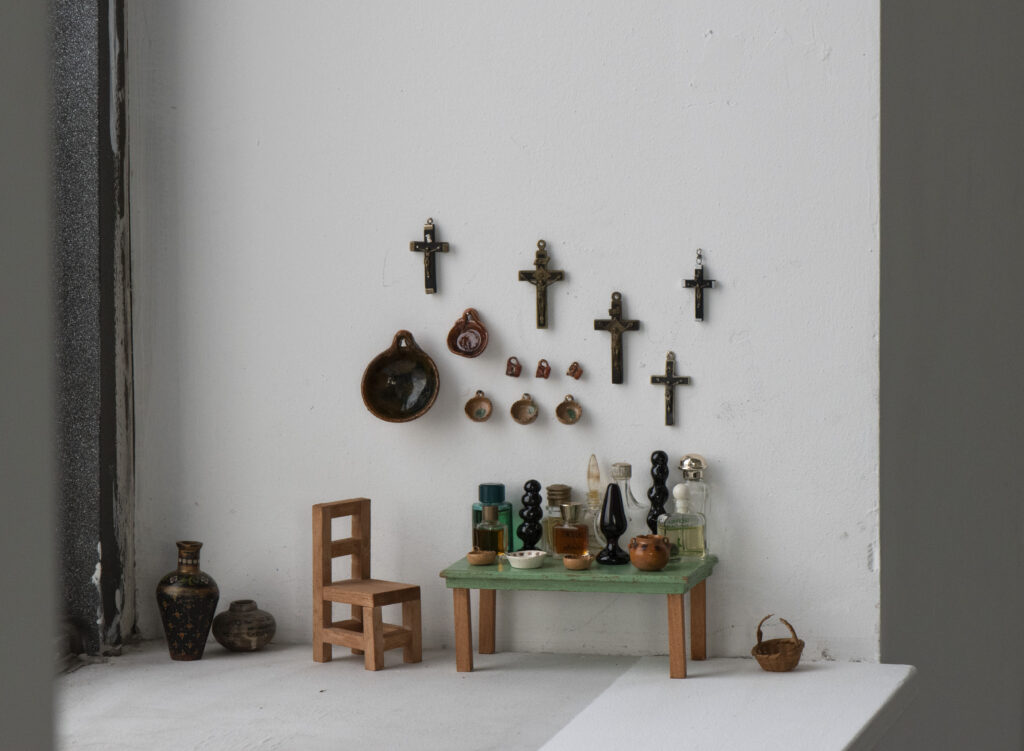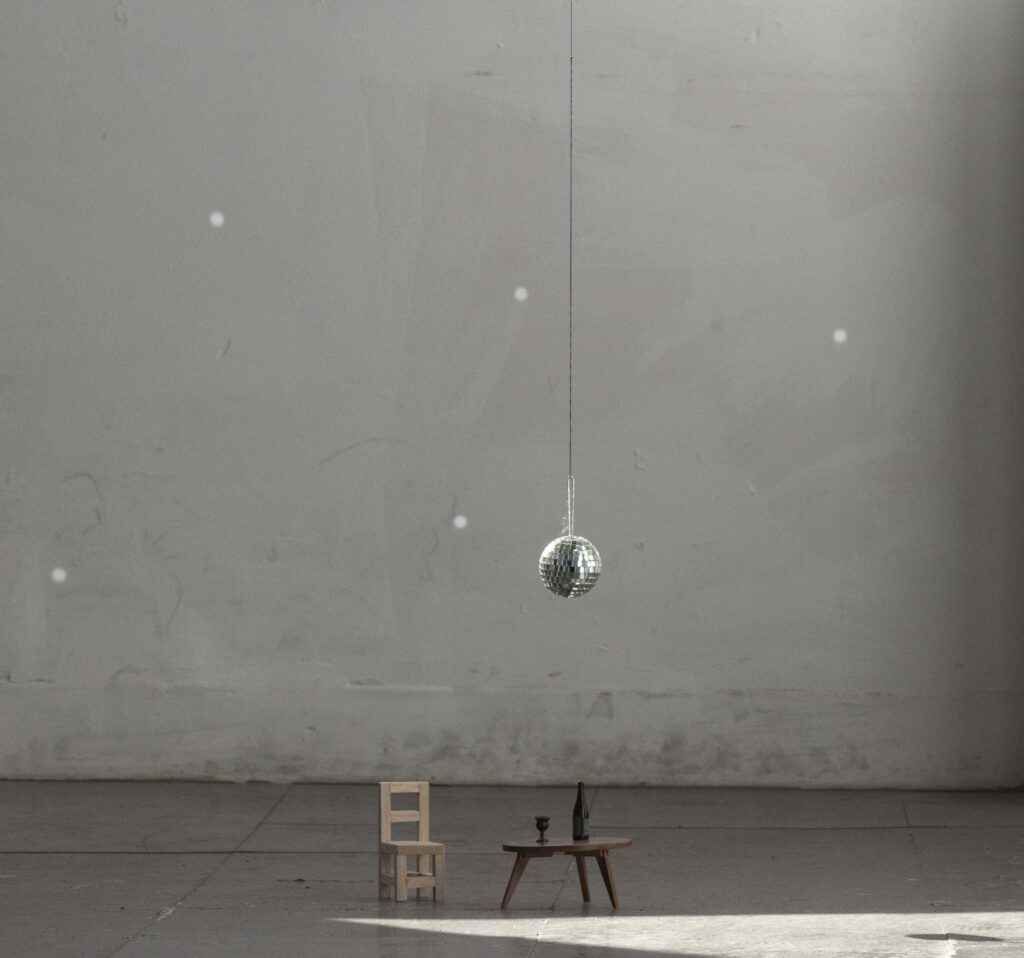
Installation at the New York Art Residency and Studios (NARS) Foundation, Brooklyn, 2024.
. . . to look for ways to describe:
Roberto Barbosa
Roberto Barbosa (b. 1990, Guadalajara, Mexico) creates scenarios using sculpture and video to describe the emotional tenor of his evolving identity – as a Mexican now living in Germany, as a queer man, and as one who defies social norms. His sculptures, miniature architectural models that he calls portals, derive from a childhood playing la comidita (the small meal) with made-up objects. This enactment of everyday domestic rituals brings to mind the Mexican popular tradition of miniatures, miniscule kitchenware, toys, or animals, and nichos, dioramic displays of such objects, found in tourist markets but also beloved by Mexicans. Barbosa has utilized such items, as well as old dollhouse furniture, sample-size perfume bottles, and found objects, to create his own small worlds. The scenarios he arranges – a wooden table with one chair, a dresser set with small objects, or a wall covered with crosses – feel simultaneously familiar and surreal.

Installation at the New York Art Residency and Studios (NARS) Foundation, Brooklyn, 2024.
An early artistic influence for Barbosa was the Italian architect and artist Aldo Rossi (1931-1977), a progenitor of postmodernism who painted scenes of empty urban spaces that are themselves reminiscent of surrealism and of miniature worlds. In his theoretical writings, Rossi spoke of the city as the locus of a collective memory; its buildings gain life with the habitation of people. When Barbosa creates miniature realms, he conjures both memory and potential – a space for becoming.

Video performance at the New York Art Residency and Studios (NARS) Foundation, Brooklyn, 2024.
Barbosa’s portals exist as works unto themselves as well as stage sets for brief videos which introduce human presence and movement. For one, he suspended a thumbnail-size disco ball over his table and chair and recorded the reflections of flickering light crossing over the darkened space. A banal, even forlorn scenario is transformed, creating the illusion of a larger space, of a not-quite-real magical environment. In another video, the artist performs in the same portal. Wearing high heels, he slowly enters the portal, effecting an extreme shift in scale (his platform heels are more than double the size of the table), and a suggestion of the erotic. With this kind of pared-down performance, Barbosa assumes what he calls “the dreaming body,” a form of queer, shamanistic ritual which symbolically frees him from space, time, and society,[1]

Nepantlera, 2023. Video Performance, 7:31 min. Seyðisfjörður, Iceland.
The artist has spoken of the value he places on the concept of nepantla, an ancient Nahuatl term for an in-between space. It has become emblematic for Mexican and Latinx people to denote the experience of existing between geographies, cultures, and value systems. The Chicana poet and theorist Gloria Anzaldúa (1942-2004) interpreted nepantla as “a space where you are not this or that, but when you are changing.”[2] Barbosa most amply reflects his own vision of the concept in the 2023 video, Nepantlera. Made during a residency in Seyðisfjörður, Iceland, far from any familiar geography, we again see Barbosa, nude but for platform heels and a long-haired wig, walking slowly through virgin snow. In a series of dream-like sequences, he reaches a body of water framed by dramatic, snow-covered mountains. When Barbosa enters the water, the act becomes a kind of ritual purification, a release.

Video installation at the New York Art Residency and Studios (NARS) Foundation, Brooklyn, 2024.
In 1981, Barbosa’s youthful artistic hero Aldo Rossi published A Scientific Autobiography, in which he wrote of memories based in objects, places, and forms. Rossi spoke of his quest to “… go over things or impressions, describe, or look for ways to describe.”[3] Barbosa has been engaged in a similar project, of working with materials and ideas that will allow him to visually describe the specificities of his own life. Moving deliberately, whether through the real world or the set pieces he creates, Barbosa subverts everyday realities to reach his own nepantla, aiming not to cross from one state into another, but to immerse himself fully in the inbetween, a queer imaginary of unfettered possibility.

Elizabeth Ferrer
© Elizabeth Ferrer, 2024
[1] Here, Barbosa draws from Carlos Castañeda’s writings on lucid dreaming as taught to him by the Yaqui shaman Don Juan Matus. See especially Castañeda’s The Art of Dreaming (New York: HarperCollins, 1994).
[2] Gloria Anzaldúa, Borderlands/La Frontera (San Francisco: Aunt Lute Books, 1987).
[3] Aldo Rossi, A Scientific Autobiography (trans. by Lawrence Venuti). (Cambridge, MA: The MIT Press, 1984).
© Roberto Barbosa 2024.
All rights reserved.